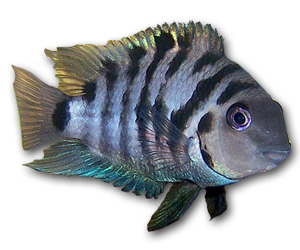Convict Cichlid

Quick Stats
| Size | 5-6" (15cm) full grown males; females an inch or two smaller |
|---|---|
| Tank | 80 litres per pair |
| Swimming Area | Lower middle |
| Ph | 6.0 to 8.0 |
| Temperature | 68ºF to 80ºF (20-27°C) |
| Food | Flakes and Frozen Foods |
Common Name:
Convict Cichlid, Zebra Cichlid.
Distribution:
Central America: Guatemala, El Salvadore, Costa Rica & Panama.
Colouration:
Also known as the "zebra cichlid"; both this and "convict" are good descriptions of this species. It has black vertical bars on it's bluish-lavender body. There is usually a pink tinge to it's belly, and well-kept fish will have an iridescent pattern on their fins and sides. Both the dark stripes and pink belly become more pronounced during breeding. Males usually have darker stripes and pointier fins (in addition to their usually larger size), and fully mature ones will sometimes have a bit of a hump on their head. Females have pinker bellies and are usually rounder. There is also a pink albino strain.
Lifespan:
5 to 10 years.
Maintenance:
10% weekly water changes. These fish are NOT known for their gentle dispositions, and need to be kept with other aggressive, larger fish that will hold their own (it can and will harass some fish to death). They have been known to pick fights with Oscars more than 3X's their size, and win! Best kept alone or with their own kind, but fascinating fish to watch.
Feeding:
They can be fed a variety of foods, including flakes, cichlid pellets, frozen/live brine shrimp, blood worms, and vegetables like chopped-up spinach leaves. They are omnivorous, and not picky eaters, but very greedy.
Substrate:
Sandy substrate as they love to dig.
Tank Decor:
Plants are out with this fish as they will up-root them. Artificial is the only way to go. Provide caves and other hiding places to make them feel secure.
Filtration:
Suitable for the size of tank they are housed in.
Biotype:
River watershed.
Breeding:
Breeding Convicts is about as hard as saying "breeding Convicts". They are very prolific, to say the least; almost as prolific as some live bearers even though they are egg layers. It is not hard to get a pair to form; usually, just putting a male and female together does the trick. Yes, it is that simple.
The spawning ritual may begin with the male courting the female. He does a vertical dance while his coloration begins to rapidly change to darker more vivid shades. The female will flare at him as he is puffing up. She, too, begins to do this same display. Soon after, the female gets right to work cleaning an area around a chosen rock, flower pot, cave, etc., moving any rocks or sand around it the best she can. The female, once satisfied with the nest, will begin to lay about 20-40 eggs, usually on the upside of a pot or cave, and the male will follow up to fertilize them. They will continue this until 100-300 eggs have been laid, depending on the females size. The female will then begin fanning the eggs with her fins while the male keeps an eyeful watch over the nest. At this point, the pair's aggression is at an ultimate high and it is critical for any life forms near by.
Before the eggs hatch, the female will dig a pit to which they will transfer the young. The eggs will hatch between 48-72 hours and the wrigglers will feed on their yolk sacs for about 6-8 days. The parents will retrieve any strays and the female will continue watching over the young while the male viciously guards them with his life.
The wrigglers become free swimming after about a week and at this point are needing to be fed foods such as baby brine shrimp, daphnia or finely crushed flakes. The mother will attempt to search for food by stirring up the substrate with her belly (if its sand of course), in hopes to find organic matter for the young to feed on. After a couple weeks, you will want to remove the young from the tank if you plan to raise them and the process will start all over. Sometimes a young pair will eat some of the young. This behavior is mostly attributed to the female, and the male generally will severely punish her for it. In this case, you should remove her or divide the tank. If you leave the fry in the tank too long, the female will almost certainly eat them after they grow a bit, and same scenario, the male will viciously chase her down and pummel her. For the most part though, Convicts are great parents.
Sexing this species is rather simple. Convict males usually have longer dorsal and anal fins with filaments trailing from the caudal fin upon reaching a mature age. They are often larger than the female. They also tend to grow a nuchal hump. Females are more brightly colored with an orange underside and brighter coloration through the fins.